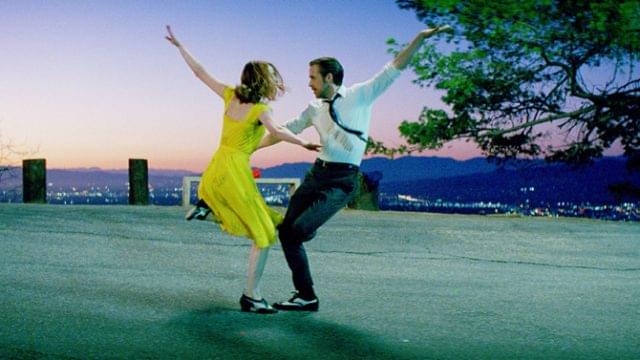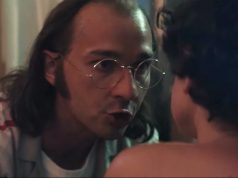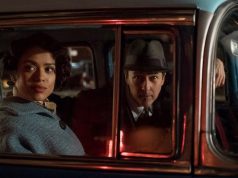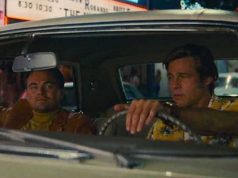
“La La Land” is a musical from the writer-director of “Whiplash” (my favorite film of 2014), starring Ryan Gosling and Emma Stone, set in Tinseltown, heavily influenced by “The Umbrellas of Cherbourg” (one of my all-time favorite films). In other words, it may have been built in a lab specifically to appeal to me. I’m flattered.
This perpetually sunny, bittersweet, primary-colored fantasia begins in a December traffic jam populated by L.A. strivers, all rehearsing their lines or going over their music on their way to their auditions or day jobs. Two of them are Mia (Emma Stone), a struggling actress who works at a coffee shop; and Sebastian (Ryan Gosling), a jazz pianist who pays the bills playing dull Christmas standards but wants to open his own club. Mia and Sebastian meet, then continue to bump into each other over the next several months as they pursue their own lives.
The story eventually becomes a romance, of course, in L.A. fashion. Mia and Sebastian go to a screening of “Rebel Without a Cause,” then visit the Griffith Observatory, where that movie’s climax takes place. Sebastian, unable to open his club yet but wanting to be a responsible adult, accepts a gig playing with an old acquaintance, Keith (John Legend), whose band mixes classic jazz with hip-hop, which Sebastian feels conflicted about. Mia goes to auditions where she acts her soul out in front of semi-attentive casting agents.
Damien Chazelle’s screenplay offers simple conflicts, mostly centered on the age-old battle between ambition and love. He makes sure we grasp that Mia and Sebastian are genuinely talented, not hopeless dreamers (or not just hopeless dreamers, anyway). Mia’s acting is soulful and impeccable; Sebastian plays and composes skillfully; and Chazelle trains the camera on them when they’re working so we can see it. (Yes, that’s really Gosling tickling those ivories.)
The songs (music by Justin Hurwitz, lyrics by Benj Pasek and Justin Paul) are catchy, jazz-tinged ditties, and they include a charming “no, we’re not falling in love, no sir” number, complete with a bit of tap dancing. In every instance, Chazelle and his cinematographer, costumers, and other technicians seek to recreate the widescreen Technicolor exuberance of old musicals, not just in content but in appearance. That means when Gosling and Stone dance, we see them from head to foot, in steady shots that linger for many seconds at a time (the opposite of, say, “Chicago,” which I adore but which is shot like a music video).
And it means our connection to them is based on character and emotion more than plot or conflict. Mia’s wide-eyed beauty, Sebastian’s bemused intensity, the inside jokes they establish as their relationship develops: these are people we enjoy spending time with. Gosling’s performance is understated and funny (his comedic skills always sneak up on you), while Stone’s starts slow and builds to a bravura climax.
Now, as much as I love the film, with its stylized reality and romantic heart and flights of fancy, it has a troubling flaw. The combination of breathy singing (they’re not beltin’ it out for the cheap seats) and unwise sound mixing makes it difficult to hear the lyrics during the first two numbers — a bad way to start a musical! (I’ve seen it twice, once in a theater and once on DVD with a good home stereo system, and it was the same.) It’s a weird misstep for a movie that’s otherwise so meticulous about its aesthetic, but it would take a lot more than that to kill the deeply felt warm-and-fuzzies it inspires.
John Legend delivers what I think is the key line. Sebastian wants to keep jazz music alive and introduce it to the next generation, but he doesn’t want to modernize or change it. Legend says, “How are you going to be a revolutionary when you’re such a traditionalist?” Sebastian doesn’t have an answer to that, but he would if he watched “La La Land,” a film so unabashedly traditional that it feels revolutionary. Technology lets Chazelle do things Busby Berkeley couldn’t do — stage an elaborate, single-take musical number on an actual L.A. freeway, for example — but Chazelle doesn’t modernize the vintage storyline, doesn’t use choppy 21st-century editing, and doesn’t approach any part of it ironically. To make an earnest, gleeful song-and-dance musical in 2016 with no political subtext or social commentary, not as a parody or deconstruction but simply as an old-fashioned ode to dreaming, is revolutionary.
A- (2 hrs., 8 min.; )





